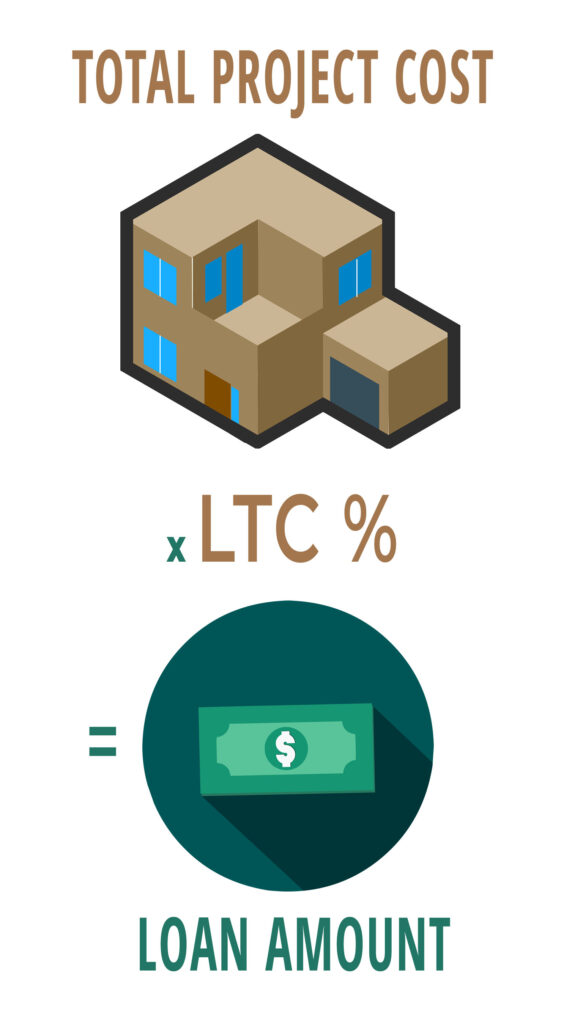Loan-To-Cost (LTC) ratio is a metric used by commercial real estate lenders to help determine how much money they should lend to a borrower for a real estate project. It’s one of the main factors Enact Partners uses to size loans, along with Loan-To-Value (LTV), Loan-To-Purchase-Price (LTPP), and Debt Service Coverage Ratio (DSCR).
Borrowers need to know about LTC, how it’s calculated, and the factors involved because it directly affects the amount of money they can borrow vs. how much of their own cash they will need to bring in to secure a loan.

What is LTC?
LTC is simply the “Loan Amount” divided by the “Total Project Cost,” expressed as a percentage, such as 75%.
For example, if the total cost to purchase an apartment building is $2,000,000 and a lender is willing to lend up to 75% LTC, the loan amount will be $1,500,000. The borrower must bring in $500,000 cash to complete the purchase.
Lenders are willing to lend at higher LTC ratios on projects perceived as less risky. For riskier projects, lenders protect their investment (the loan) by lending at a lower percentage LTC, which requires borrowers to bring in more of their own cash.
Why is LTC Important to Lenders?
LTV, LTPP, and DSCR are considered mechanical metrics that measure a property’s ability to cover loan payments or be financially appealing to another buyer. (We’ve already explored LTV, and we’ll look at LTPP and DSCR in future blogs.) LTC is a bit different. It’s more about borrower psychology. Essentially, the riskier the loan, the more lenders want borrowers to have “skin in the game.” That way, borrowers are less likely to walk away from a project should they run into trouble completing it.
It’s a worst-case scenario if a lender is forced to foreclose and take over a property, especially on a partially-completed construction project. By requiring borrowers to bring in more of their own cash, they are more likely to find solutions to problems and pay off the loan.
How is LTC Percentage Determined?

LTC ratio is not a fixed percentage. As a general rule, the riskier and more difficult a project is, the more cash borrowers will be required to commit.
Determining the required LTC ratio depends on many factors. These include:
- Loan type (long-term, bridge, construction, development)
- Property type (multifamily, single-family, land, retail, office, industrial, hospitality, special purpose)
- Property location
- Market conditions
- Type of lender (whether a bank, private lender, insurance company, or some other entity)
- Lender’s current appetite for funding loans.
Typically, borrowers can expect the following maximum LTC ratios:
- Stabilized residential rental property: 75% to 80%
- Stabilized commercial rental property: 75%
- Vacant property: 50% to 75%
- Construction: 50% to 75%
- Land: 30% to 50%
While Enact Partners does NOT lend on personal residences, in case you were wondering, LTC ratios for personal residences ranges from 80% up to 95% for FHA loans (or 100% for VA loans).
Remember, the higher the LTC, the more funds come from the loan, while the lower the LTC, the more funds come from borrower cash.
What is Total Project Cost and How is it Determined?
Total Project Cost includes all project costs previously incurred by the borrower. This includes the following:
- Property purchase price
- Soft costs such as entitlements, architect, engineer, permits, impact fees, environmental studies
- Hard costs already spent
- Anything that has added value to the property in the eyes of the lender.
Total Project Cost can also include all project costs that will be incurred by the borrower now or in the future. This includes the following:
- Property purchase price
- Existing loan payoff amount
- Projected soft costs such as entitlements, architect, engineer, permits, impact fees, and environmental studies
- Projected hard costs such as utilities, grading, framing, plumbing, and roofing
- Contingencies
- Interest reserve and financing costs for the new loan
- Anything that the lender believes will add value to the property.
Total Project Cost does not include the following items (although these are real costs, they do not add value to the property, so the lender will not consider them in their Total Project Cost calculation):
- Financing costs for previous loans
- Interest spent on previous loans
- Old appraisals
- Entitlement costs for a plan that was later changed or abandoned
- Leasing broker fees.
Some items may or may not be included, depending on the circumstances:
- Fees developers pay themselves for their time and overhead – These fees MAY be included in the Total Project Cost if the fees are considered reasonable and the developer has a track record of reliability.
- Imputed equity from increased market prices – Let’s look at examples of when this MIGHT BE included and when it MIGHT NOT BE.
An example where imputed equity most likely would not be included:
- A borrower purchases a single-family rental home for $1,000,000 in February 2020, using an $800,000 loan and $200,000 in cash.
- COVID causes a housing price spike in certain markets and in May 2022 the house is now “worth” $1,500,000.
- The borrower asks for a $1,200,000 cash-out refinance at 80% LTV.
- Most lenders would not do this loan because the borrower has only owned the property for a short time and the COVID-related spike is not indicative of long-term value. (Also, by May 2022 interest rates were already on the rise with housing prices expected to fall to more normal levels.) A lender would not trust the $1,500,000 current value and either pass on the loan or offer a lower loan amount.
- In addition, if the lender were to provide a $1,200,000 loan, the lender would in essence be paying off the $800,000 purchase loan, returning the borrower’s $200,000 downpayment AND giving the borrower $200,000 in profit, making it VERY easy for the borrower to walk away if there are future issues.
Here’s an example where imputed equity might be included:
- A borrower’s family purchases a piece of land in 1985 for $20,000. Now, 38 years later, the land is worth $2,000,000.
- The borrower spends $200,000 in cash, entitling the land for an apartment building.
- The borrower is seeking a construction loan and wants credit for $2,200,000 “cash” spent to-date.
- A lender MIGHT give the borrower credit for the $2,000,000 land value as “cash” into the project because the borrower has owned it for so long. It’s also helpful that the borrower will have to put in additional cash for the construction loan.
Do Investor Funds Count Toward Total Project Cost?
Investor funds do count, but it’s important that the developer (or the general partner or person who signed a personal guaranty) has sufficient skin in the game too, not just the investors. Lenders look at developers as the ones who ultimately make the decisions, so they want to ensure developers are motivated to complete their projects as intended.
How Enact Partners Can Help
LTC ratio is important for every type of loan, but especially for land, development, and construction loans. Lenders never want to “get the keys back” from a borrower who decides to walk away from a project. One way to lessen that likelihood is to make sure borrowers bring some of their own hard-earned cash to the table. That’s why LTC is important to lending decisions made by Enact Partners.
While banks and institutional private lenders have all but stopped approving real estate and construction loans, we continue to lend. For us, the current lending environment is an opportunity to keep doing what we’ve always done, which is to lend responsibly to qualified borrowers.
We’ve always relied on the borrower and the project to inform our lending decisions, so we continue to lend on projects with solid fundamentals—whether for land acquisition, construction, value-add, or bridge loans. Given our extensive experience in real estate, land development, and construction, we are confident in our ability to provide borrowers and builders the capital they need to acquire and develop property.
Contact Us About Your Borrowing Needs
(760) 516-7776 | [email protected] | www.enactpartners.com





